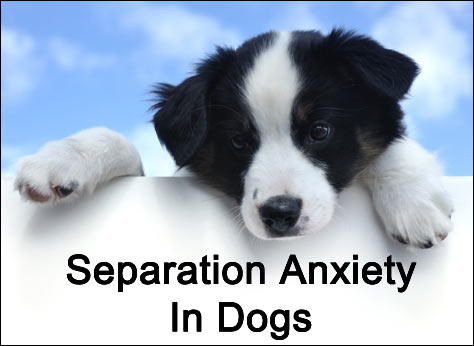How To Help a Dog With Separation Anxiety?


For most of the pet owners, one of the most common complaints is that their dogs are destructive and disruptive when left alone. Their canine companions might defecate, urinate, bark, chew, howl, dig or try to escape. All these problems often indicate that your pooch needs to be taught polite house manners. But, discipline or house manners might not be the remedy for this disruptive behavior, which might be the sign of Separation Anxiety.
Is your canine companion suffering from separation anxiety?
You can check the problem of separation anxiety in your dog with the help of following statements. If most, or all, of these statements are true about your canine companion, he may have a separation anxiety problem:
- The destructive and disruptive behavior in the dog occurs primarily when he is left alone and typically begins soon after the owner leaves
- The dog follows his owner from room to room whenever the owner is in home
- The dog displays effusive and frantic greeting behaviors
- The destructive and disruptive behavior in the dog occurs whether he is left alone for short or long periods
- The dog reacts with depression, excitement, or anxiety to the preparations of owner to leave the house
What causes the separation anxiety in Dogs?
It is not fully understood why some pooches suffer from the separation anxiety. But, it is important to realize that the destruction that often occurs with the separation anxiety is the part of panic response and your canine companion is not trying to punish you for leaving him alone. Some scenarios that can trigger separation anxiety are as follows:
- The dog accustomed to constant companionship of his human friend is left alone for the first time
- The dog suffers a traumatic event (from his point of view), such as time at a shelter or boarding kennel
- Any change in the routine or structure of family or the loss of a family member or other pet
How to help dog with separation anxiety?
You can follow below mentioned tips to help your dog with separation anxiety:
- You should make leaving and arriving home unexcitable i.e. do not greet your pooch too enthusiastically when you come back home and do not make a fuss when leaving. This is hard to do, but it can help your canine companion with the separation anxiety.
- You can give your canine companion a hard rubber chew toy to keep him busy while you are away from him. When your dog chews it, he will not destroy furniture or other items and will also not bark incessantly.
- You can leave an article of clothing or towel or a blanket out so that your canine companion can pick up your scent while you are gone. It can comfort your dog and help with separation anxiety.
- You should act like you are going to leave, but do not. For example, get your coat and car keys, but then sit down for while. You can practice doing this until your canine companion shows no sign of separation anxiety.
- You can give your pooch a 20-25 minute vigorous walk or more before you leave. It will take some extra effort from your side, but it really wears your dog out. Get your dog tired so that he spends more time snoozing than worrying about you during the time you are gone.

Hailing from Delhi, Prateek Tiwari is an avid animal lover who believes in Mahatma Gandhi’s quote “The greatness of a nation can be judged by the way its animals are treated.” A graduate in Biotechnology, he has vast knowledge about different breeds of pets and pet food that are both nutritious and promote healthy growth. In order to make people aware about pets and pet care, he shares his expertise through his blog posts.

![]() +91-8744012053
+91-8744012053
.png)


![]() +91-8744012053
+91-8744012053
.png)

